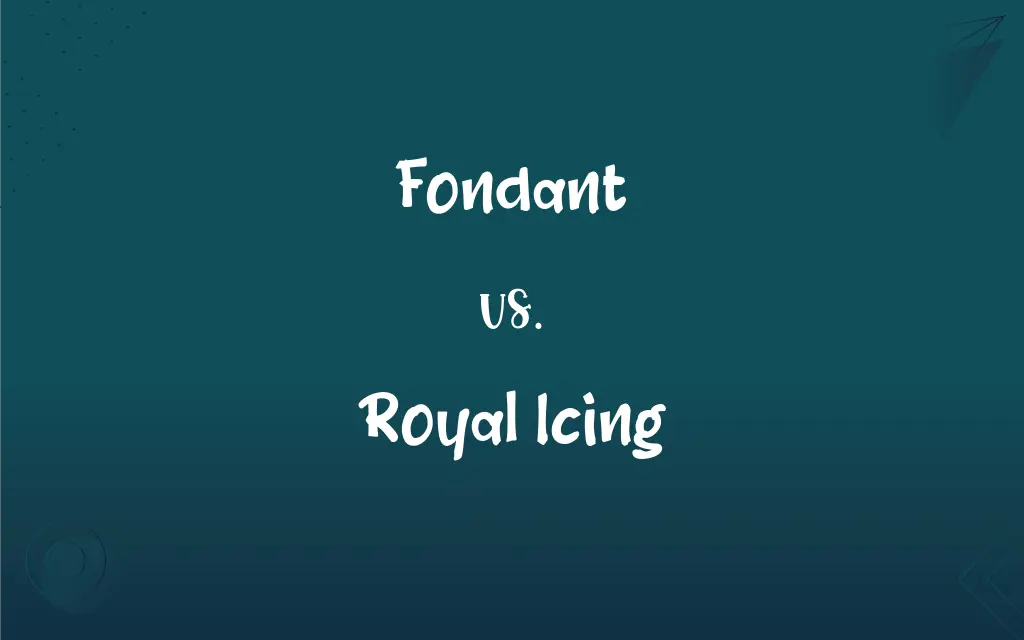Fondant vs. Royal Icing: What's the Difference?
Edited by Aimie Carlson || By Harlon Moss || Updated on October 19, 2023
Fondant is a pliable, smooth sugar paste for cake covering; royal icing is a hard-drying, smooth mixture primarily of egg whites and powdered sugar.

Key Differences
Fondant is a type of icing that is known for its smooth and pliable consistency, making it perfect for creating sleek and shiny cake surfaces. On the other hand, royal icing, with its hard-drying nature, is often favored for detailed work like piping and creating intricate decorations.
While fondant can be rolled out and draped over cakes, giving them a polished appearance, royal icing is typically applied with a piping bag, lending precision to designs such as lacework or flowers on baked goods.
In terms of ingredients, fondant is primarily made of sugar, water, and gelatin or glycerine, resulting in its dough-like texture. In contrast, royal icing's main ingredients are egg whites and powdered sugar, which, when combined, produce a smooth, fluid mixture that hardens upon drying.
When it comes to versatility, fondant can be tinted, flavored, and even sculpted into figures or shapes. Royal icing, though less flexible in form, can be colored and adjusted in consistency, depending on whether it's being used for flooding cookies or intricate piping.
Storage conditions differ for cakes decorated with these icings. Cakes covered in fondant should be kept in cool, dry places to maintain their form and finish. Items decorated with royal icing, due to its ability to harden, can be stored at room temperature once the icing sets.
ADVERTISEMENT
Comparison Chart
Consistency
Pliable and smooth
Hard-drying and smooth
Application
Rolled out and draped over cakes
Piped using a bag
Main Ingredients
Sugar, water, gelatin/glycerine
Egg whites and powdered sugar
Versatility
Can be tinted, flavored, sculpted
Can be colored, adjusted in consistency
Storage
Kept in cool, dry places
Stored at room temperature once set
ADVERTISEMENT
Fondant and Royal Icing Definitions
Fondant
Often used for sculpting decorative figures.
He created a fondant unicorn for the birthday cake.
Royal Icing
A hard-drying icing made from egg whites and powdered sugar.
She used royal icing to pipe delicate flowers.
Fondant
Known for its pliable consistency.
She molded the fondant into a beautiful rose.
Royal Icing
Commonly used for intricate piping work.
The lacework on the cookie was done with royal icing.
Fondant
Can be rolled out to cover cakes.
The fondant layer gave the cake a polished look.
Royal Icing
Sets hard and is ideal for decorating cookies.
Once the royal icing on the cookies dried, they were stacked.
Fondant
Provides a sleek and shiny finish to desserts.
The fondant shine made the cake look professional.
Royal Icing
Can be adjusted in consistency for different decoration purposes.
She thinned the royal icing for flooding the cookie surface.
Fondant
A smooth, elastic sugar paste used in cake decoration.
She covered the cake with a layer of fondant.
Royal Icing
Known for its smooth consistency when wet.
The royal icing flowed effortlessly from the piping bag.
Fondant
A sweet creamy sugar paste used in candies and icings.
FAQs
Which is better for cookie decoration?
Royal icing is preferred for cookies as it dries hard and is ideal for detailed work.
Can I color and flavor both fondant and royal icing?
Yes, both fondant and royal icing can be tinted and flavored as per preference.
Does fondant dry hard like royal icing?
No, fondant remains pliable and soft, unlike the hard-drying nature of royal icing.
Can royal icing be used to cover cakes like fondant?
No, royal icing is mainly for piping and detailed decorations; it hardens when dry.
How long does royal icing last once made?
Royal icing can last up to a week if stored in an airtight container in the refrigerator.
Can I use buttercream under fondant?
Yes, a thin layer of buttercream is often applied to cakes before covering them with fondant.
What is the primary use of fondant in baking?
Fondant is primarily used to cover cakes, providing a smooth finish.
How do I store fondant-covered cakes?
Fondant-covered cakes should be stored in a cool, dry place, not in the refrigerator.
Does fondant have a particular taste?
Fondant is sweet, with a marshmallow-like taste, but flavorings can be added.
What are the main ingredients in fondant?
Fondant's main ingredients are sugar, water, and often gelatin or glycerine.
Can I make royal icing without egg whites?
Yes, meringue powder can be used as a substitute for egg whites in royal icing.
Do I need special tools to work with fondant?
While not mandatory, tools like rolling pins, smoothers, and cutters can help in working with fondant.
Can I refrigerate a fondant-covered cake?
It's best to avoid refrigeration as it can cause the fondant to sweat and become sticky.
Why does royal icing harden?
The combination of egg whites and powdered sugar in royal icing causes it to harden when exposed to air.
Is fondant edible?
Yes, fondant is edible, though some choose to remove it due to personal taste preferences.
Is royal icing safe for people with egg allergies?
Traditional royal icing contains egg whites, so alternatives should be considered for those with allergies.
Is it hard to work with fondant?
There's a learning curve, but with practice, working with fondant becomes easier.
Can I use royal icing on cupcakes?
Yes, royal icing can be used on cupcakes for intricate designs or as a glaze.
Can I make flowers with royal icing?
Yes, royal icing is perfect for piping detailed flowers and decorations.
How do I achieve a runny consistency with royal icing?
Add small amounts of water until you achieve the desired consistency for royal icing.
About Author
Written by
Harlon MossHarlon is a seasoned quality moderator and accomplished content writer for Difference Wiki. An alumnus of the prestigious University of California, he earned his degree in Computer Science. Leveraging his academic background, Harlon brings a meticulous and informed perspective to his work, ensuring content accuracy and excellence.
Edited by
Aimie CarlsonAimie Carlson, holding a master's degree in English literature, is a fervent English language enthusiast. She lends her writing talents to Difference Wiki, a prominent website that specializes in comparisons, offering readers insightful analyses that both captivate and inform.































































